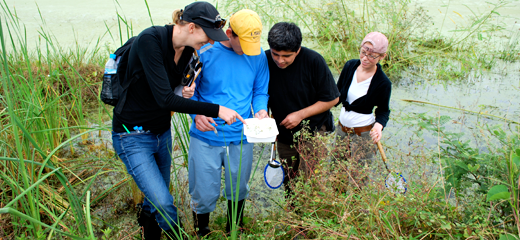LIMA
El Comedor/University of Cayetano Heredia
Malnutrition affects thousands of Peruvian children each year. UNICEF has estimated the prevalence in children less than five years old at 18% in urban areas, and up to 33% in rural areas of the country. Risk factors include food insecurity, rapid population expansion, poverty and economic disparities, and high prevalence of communicable diseases.
El Comedor is a community-based project supported by the Universidad Peruana Cayetano Heredia and UTMB. Its purpose is to improve the nutritional status of children under the age of 3 in the town of Ermitaño Alto, in the Independencia District of Lima. Over the course of six months, El Comedorprovides two nutritious meals five days a week to children between 6 and 36 months who are either currently malnourished or deemed to be at risk for malnutrition. An on-site dietician and nutritionists also teach mothers how to use low-cost, locally relevant ingredients to prepare healthy meals for their children, and educate them on the importance of good nutrition for optimal physical and mental development. UTMB and UPCH are working together to establish opportunities for their students to work together on collaborative projects that serve the mission of El Comedor.
Field Epidemiology Course (Lima and Tumbes, Peru)
This course is open to students from all four schools at UTMB through an application process. The course is held during the summer and taught by Dr. Willy Lescano from UPCH and Dr. A. Clinton White from UTMB. The course activities evolve around the investigation of a simulated outbreak of febrile illness in a town in northern Peru.

During a 2-week period, the 10 steps of an outbreak investigation proposed by the CDC are introduced and applied directly in the field. Work is intense, exciting, and focused on hands on activities. Students learn about rapid response teams, logistics for field activities, cases and controls tracing, vector and reservoir trapping, handling, dissection, and specimen collection. They also learn about vector control, surveillance of influenza virus reservoirs, and eradication of human and animal cysticercosis. Overall, the course demonstrates that team work and field epidemiology are not only enjoyable, but can make a difference in the lives of people in resource poor settings.
CUSCO
UPCH – UTMB Collaborative Research Center
The UPCH – UTMB Collaborative Research Center was founded as a joint effort to augment research and educational capacity in the Cusco region. It was officially opened in January of 2012 by Dr. Eduardo Gotuzzo (Director, IMTAvH), Dra. Fabiola León Velarde (Rector, UPCH), Dr. A. Clinton White (ID Division Director, UTMB), and Dr. Miguel Cabada (Director, UPCH-UTMB Collaborative Research Center). Please click here to see photos from the opening ceremonies.

The Center's current research focuses in 2 areas: diseases of travelers to Cusco (including traveler's diarrhea and altitude illness) and parasitic disease in the surrounding region. Dr. Cabada was recently funded by NIH to study the impact of fascioliasis in the community. Through a network of local relationships, the Center offers experiences in community health/development, research, language training, and clinical medicine for UTMB trainees.